
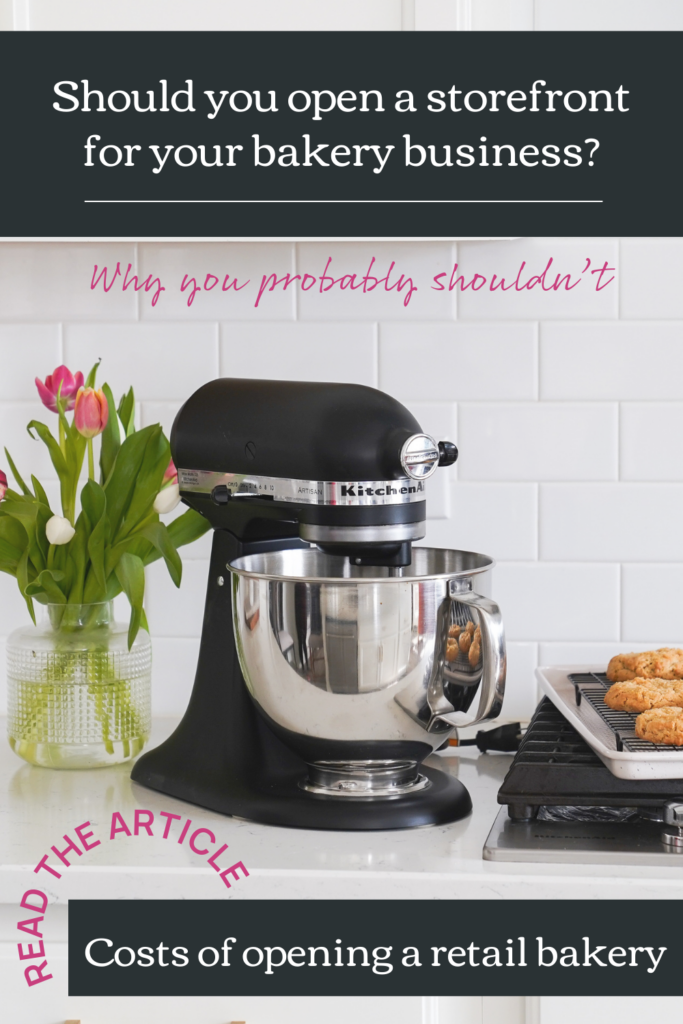
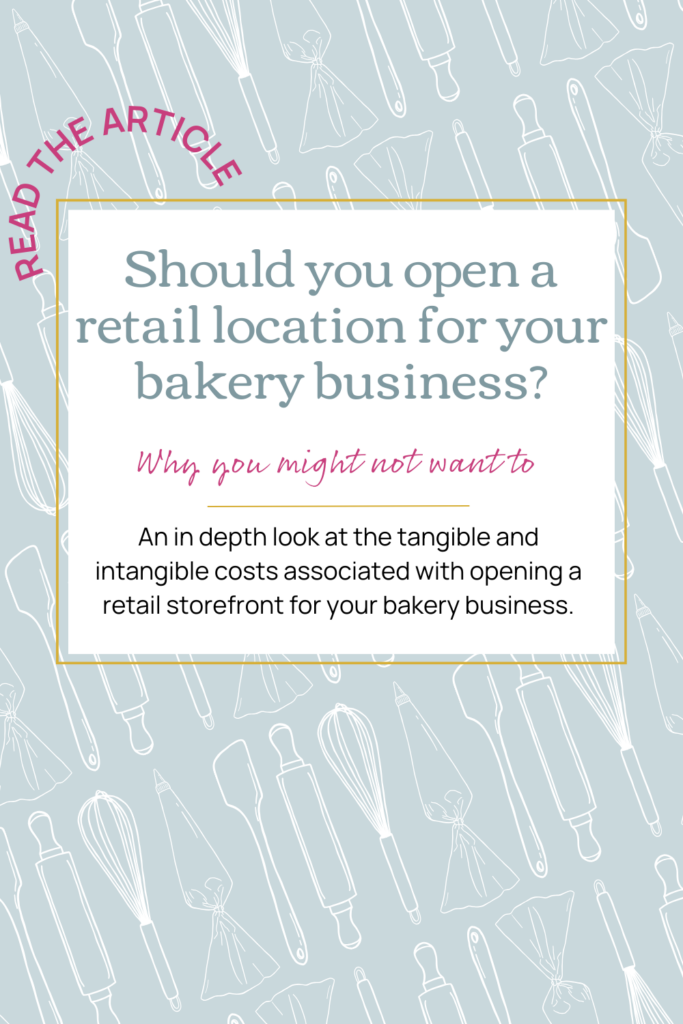
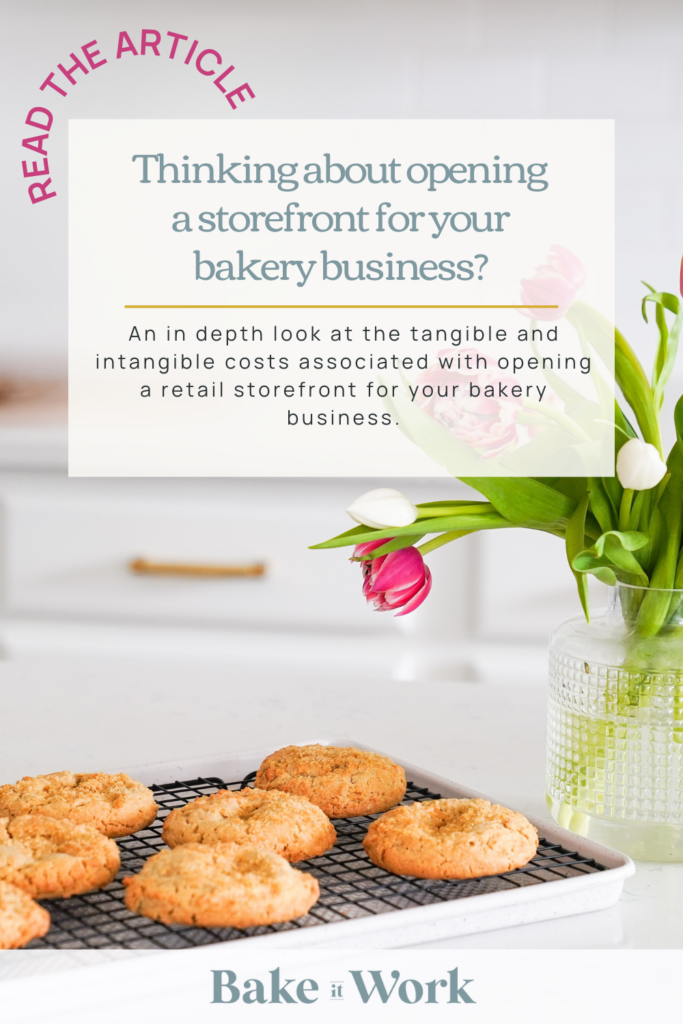
The Short Answer: Probably Not.
Hi, I’m Aryn, a bakery business coach with over fifteen years of experience running my own bakery as my full-time job and only source of income. I help small bakery owners navigate the business side of baking, and today, I want to share why opening a storefront may not be the best end goal for your bakery business.
Many home bakers dream of growing their business into a retail storefront. Time and time again, I coach bakers who believe that a storefront will solve their business challenges—lack of space, inconsistent sales, or no dedicated pickup location. However, the reality is that opening a storefront comes with significant financial risks and operational challenges that can often outweigh the benefits.
Running a bakery business is seriously hard work, and success (in my books) is being able to earn the most possible income from the effort put in. In today’s business climate, opening a storefront does not necessarily mean bigger profits. In many cases (your state’s cottage food laws depending), you can grow your business to a point where you’re earning more than you would with a storefront—all while maintaining personal freedom and avoiding massive financial risk. That’s a win-win-win if you ask me! Here’s why a storefront might not be the best move for your business:
A storefront should not be your “end goal”.
- When I coach, I hear it all the time: “I want a storefront, and then I’ve made it!” But this is actually a pretty short-sighted goal. Successful entrepreneurs start with the end in mind—meaning they plan for how they’ll eventually exit the business. Think about your longer term goals. Achieving a storefront location means nothing if you never get to retire! Or worse, your business eventually fails because you were so focused trying to get a storefront that you forgot to think about what happens after that.
Loss of freedom
- this is the BIGGEST change in going from home baking to a storefront location and one that I think most bakers grossly underestimate. I truly do not mean to seem harsh here, BUT it is important to understand that as long as you have a storefront location you will likely be reducing (if not eliminating altogether) vacations, holidays off, family time, and those random afternoons that you are able to enjoy off when you are not required to keep a storefront open. You may be thinking to yourself “ that is what employees are for” but let me tell you, as a storefront owner for many years I can assure you that even with the best of employees you are still getting phone calls from them about all sorts of random things that pop up. Some quick examples: leaving the family dinner table to drive back to work at closing time for the employee that forgot to bring their key to work, watching the cameras each evening to make sure employees get out safely to their cars, and covering shifts when employees are sick etc. You are never truly “free” and this can be quite taxing if you value personal time and flexibility.
A Storefront Doesn’t Give You More “Legitimacy”.
- I totally get it—sometimes, the idea of having a brick-and-mortar space feels like the ultimate proof that you have a real business. But let me tell you a little secret: if your bakery is set up correctly and operating professionally, no one cares where they pick up their stuff. Your customers just want delicious, high-quality baked goods. I’ve coached countless home bakers running six-figure businesses without ever having a retail storefront. You don’t need a fancy building to be taken seriously!
The numbers don’t add up
- I coach a lot of bakers that think that opening a storefront means that they would get daily sales from foot traffic, and that this revenue stream covers the overhead/rent of the retail space. The reality is that the cards are stacked pretty high against you. Let’s do some quick math (don’t worry, I’ll keep it simple):
Walk in customers that visit bakeries are typically buying single items and do not spend very much per ticket. let’s be generous and say $7-$15 per ticket.
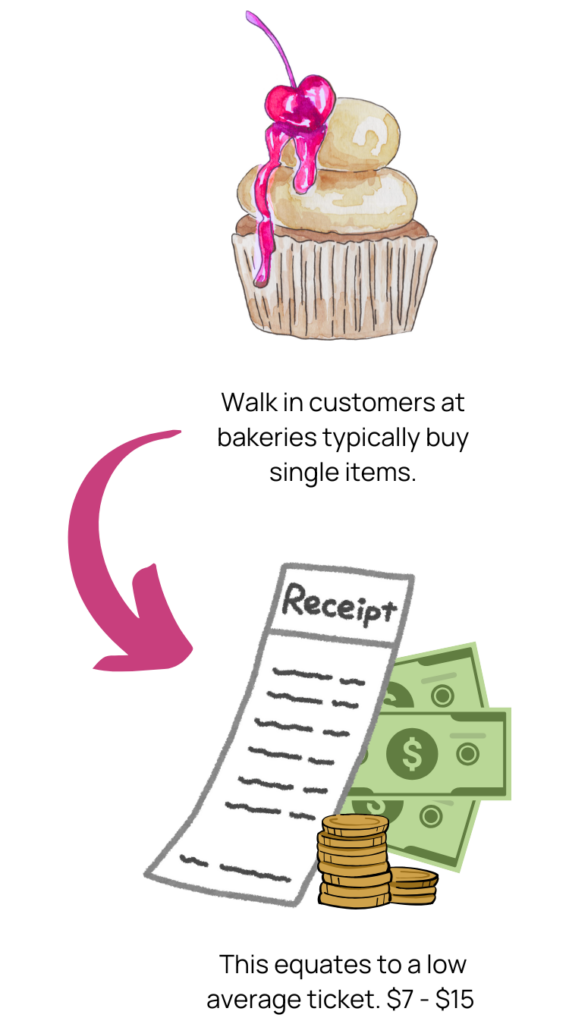
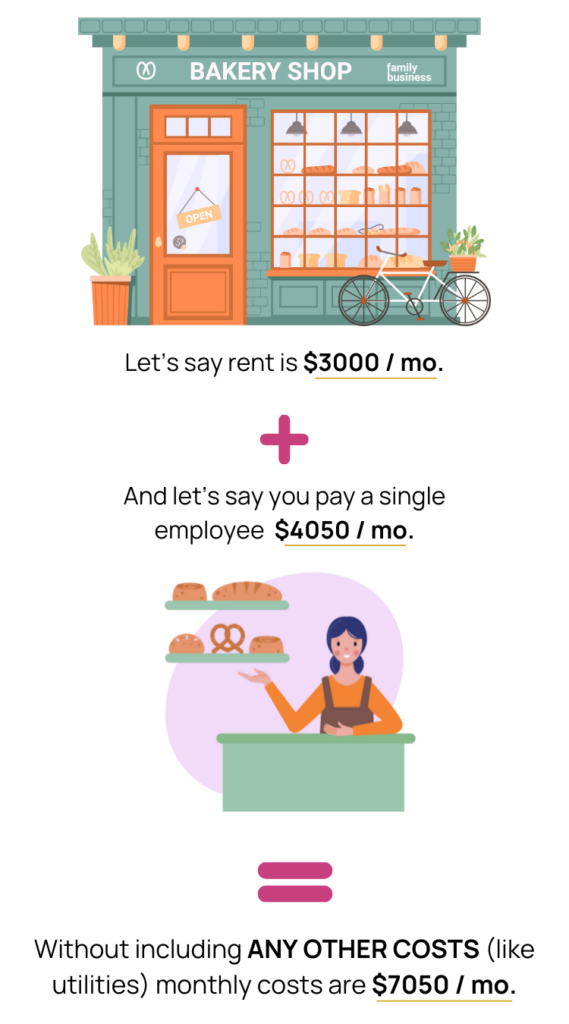
Let’s say your rent is $3,000 per month (which is actually on the lower end!).
You’re required by your lease to be open six days a week for nine hours a day.
You pay yourself or an employee $15 per hour to work those nine hours = $135 per day × 30 days = $4,050 per month.
That’s already $7,050 per month in costs (and that doesn’t even include utilities, insurance, ingredients, or other overhead expenses!).
If your average sale is $11, and $5 of that is actual profit, you’d need 47 customers per day spending at least $11 each just to break even. That’s before you even start making a profit!
You would need to serve several hundred customers per day to maintain a volume that makes it worthwhile for you to maintain a storefront location. That’s a LOT of foot traffic—more than most small bakeries can realistically count on.
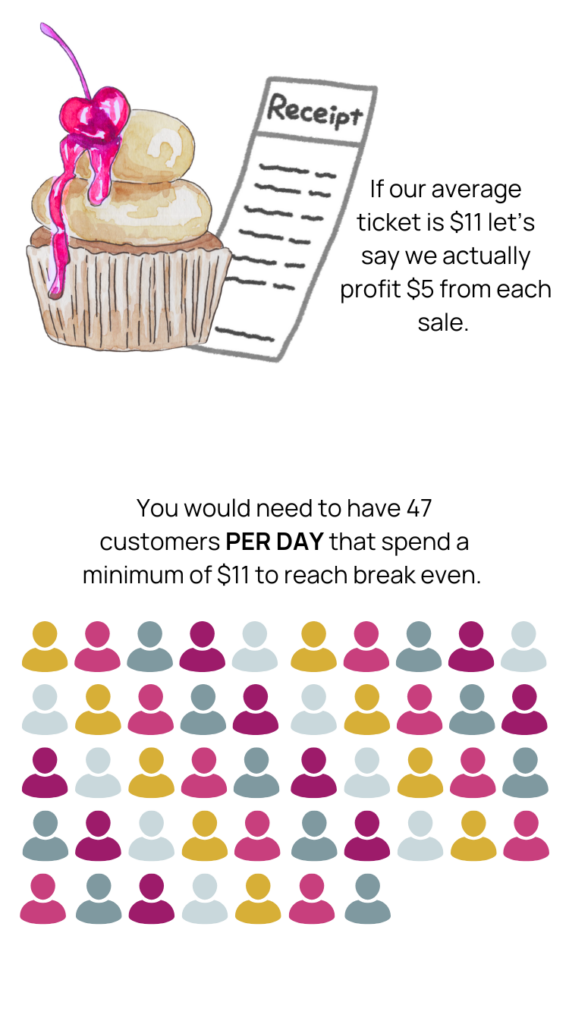
What I see far too often is that the storefront itself isn’t actually profitable—it’s being propped up by other revenue streams like custom orders, market pop-ups, or wholesale accounts. It’s easy to overlook this when money is coming in overall, but if you separate out the numbers, it often becomes painfully clear: the wedding cakes or bulk orders are making the real profit, while the storefront is quietly bleeding cash.
Instead of pouring time, money, and energy into a storefront that drains your other revenue streams, why not double down on what’s actually working? Maximizing those high-profit areas—whether it’s online sales, custom orders, or pop-ups—can often lead to greater financial success without the overhead and stress of a storefront.
That said, there are always exceptions. Storefronts can work, but a few key things need to align:
- Location, Location, Location. Bakeries need to be destinations. If you don’t have enough foot traffic, your storefront will struggle. And remember from earlier—you need hundreds of customers daily to make the numbers work. If your location is tucked away, hard to access, or doesn’t naturally attract crowds, you’re going to have a tough time keeping doors open.
- A Short-Term Plan to Sell. If your goal is to scale for a few years and then sell, a storefront could make sense. Buyers prefer businesses with a tangible location and operational structure over home-based businesses that rely solely on the owner. Having a storefront with a transferable lease and established systems in place makes your bakery far more appealing to potential buyers.
Tangible and intangible costs of opening a bakery storefront:

Build out costs – Even on a tight budget, expect to drop at least $30K to get a space ready. That’s money you’ll never get back.
Rent – Even at the lower end, modest rent typically starts at $25 per square foot. The main reason for having a storefront is foot traffic—something that can’t be replicated with other business models. But here’s the problem: in most cases, the increase in foot traffic doesn’t generate enough additional sales to justify the cost.
Think about it: if your average customer spends $7 to $15 per visit, you’d need a significant amount of daily traffic just to cover rent—before even considering payroll, utilities, ingredients, and other expenses. That’s a lot of cupcakes, cookies, or loaves of bread that need to fly out the door every single day just to break even. And if that foot traffic isn’t consistent, you’ll find yourself scrambling to make up for slow days.
Utilities – Commercial spaces = higher rates. Yay.
Insurance – insurance requirements for spaces that are open to the public are higher, and the chances of having an incident that requires you to make a claim also increase. (the general public can be crazy yall!)
Maintenance & repairs – people (including employees) do not care about your stuff like you do. Employees really tend to test the durability of your fancy new kitchen equipment and the public is happy to flush all sorts of things down your toilet, leaving you to clean up the mess and call a plumber.
Payroll – taking on payroll is a massive commitment. Hiring someone means taking their wellbeing, livelihood and paycheck is in your hands. Payroll is typically a bakery businesses largest line item, and a storefront will need 3-5 employees at minimum to keep things running.
Packaging – this seems like a small thing but having a storefront means you need to stock all types of packaging to accommodate all the ways people might want to purchase things. You can easily go from being able to get by with one or two types of boxes to needing individual boxes for each type of product along with bags & stickers etc. While this seems like it wouldn’t get out of control, its typical to have at least $1000-$2000 in sunk packaging costs in your storefront at any given time. As an added little kicker, customers always want bags – sometimes even for single items! This knocks 1-3 dollars in what would have been profit off of every purchase. It really adds up.

Loss of freedom to come and go as you please – see article above
Loss of “focused” time – One thing I didn’t anticipate when opening my storefront was just how often I’d be interrupted by well-meaning customers stopping in for a chat. Having a physical space where anyone can walk in at any time means your “regulars” can drop by whenever they please—even when you’re swamped with orders and desperately trying to focus. While I always appreciated connecting with customers, these interruptions added up and often derailed my most productive hours. What felt like just a few minutes here and there could easily turn into an hour lost, making it even harder to keep up with the daily demands of running a bakery.
Now you have to serve drinks of some kind – hope you were interested in becoming a barista! P.S. people will expect you to carry alllllll of the different milks.
The general public *can be* awful/scary – this one is one of the more sad parts of running a retail location that I don’t like to dwell on a lot but it does need to be mentioned. While 99% of my experiences with customers while running a storefront were wonderful, there were several occasions that were pretty scary. The occasional visit from someone clearly abusing substances, or the few unruly, rude or even (on one occasion) violent customers can really taint your overall outlook of serving the general public. Maintaining a safe workplace for employees and yourself is something that you must be constantly vigilant about, and even with the best of policies in place it is difficult to predict & avoid all circumstances.
Okay Aryn, well now what should I do instead?
I am writing this article hoping dearly to not sound too negative! I think on the contrary, I want to point out that you *quite likely* (unless your states cottage law is SO restrictive that your hands are completely tied) have all the tools you need to get your business driving profits without taking on all the enormous financial risk and mental load of opening a retail location.
Instead of daydreaming about a storefront, what can you do now to grow your business with the tools you have?
Can you stay within the constraints of your states cottage law and pull the strings to drive profits without increasing overhead? Can you tweak your business model? Could you invest in a new freezer to increase your potential output? What things might be causing bottlenecks in your business and what creative ways could you resolve that to drive profits? What could get your business to the next level without taking on the enormous overhead of opening a retail location?
Alternatives to storefronts:
Utilize markets as a pick up location while maintaining your home kitchen. Pre-selling for markets is a great way to increase sales, reduce waste product, and ensure that you earn income at each market regardless of what the weather is (because relying on foot traffic on rainy days at the farmers market is for the birds).
Ghost kitchen or rented space – with the rise in popularity of food trucks has come more opportunity for home bakers! Ghost kitchen space or rental kitchens can be a more budget friendly way to obtain the correct inspections and licenses needed to carry on baking legally, without the massive overhead cost associated with opening a full retail location.
A building you can purchase so that you own the asset? This is my favorite option and actually carries the least risk. Why might I say that? You won’t lose a single dime in “rent” that you are paying to yourself, instead you will be building equity. In addition, it may sound pessimistic but as a last resort, if everything goes belly up you have property to sell. In all other business models you do not have any large assets that you could sell off to recoup any lost costs.
Additional help:
If this article has you rethinking your plans, don’t panic! I’m here to help. I offer one-on-one bakery business coaching and an online course, Menu Planning for Profit, designed specifically for small bakery owners like you. If you’re ready to build a thriving, profitable bakery business— storefront or not —this course is for you!
Let’s make your bakery business work for you, not the other way around!


comments